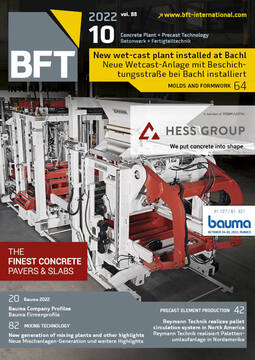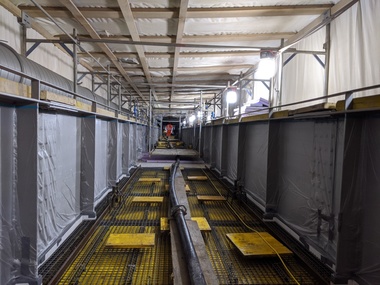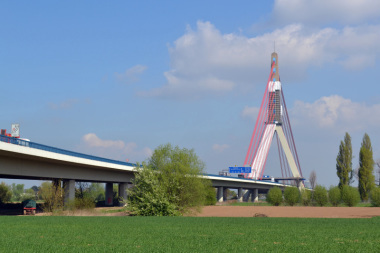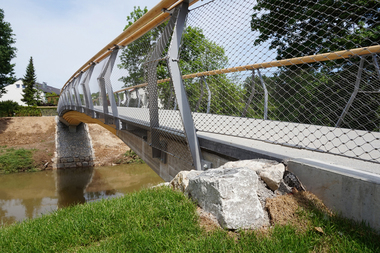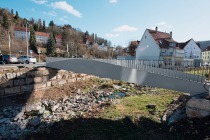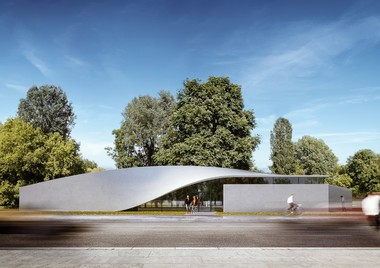Rehabilitation of the Schwaderloch bridge with
state-of-the-art concrete technology
The Schwaderloch foot and bicycle bridge has connected Germany and Switzerland across the Rhine border for many years. But the steel construction had by now become dilapidated. For its rehabilitation, the responsible parties decided on carbon concrete, since this material more easily enables considerably thinner construction elements to be realized than by using conventional reinforced concrete.
The Schwaderloch foot and bicycle bridge, built in 1934, crosses the Rhine between the communities of Abbruck (in Germany) and Schwaderloch (in Switzerland). The bridge has a width of 2.60 m, a length of more than 200 m and extends over five spans. Residents and vacationers use the bridge regularly. But in the course of time, the bridge had become dilapidated to the point that, in 2016, based on expert opinion, it was classified as being in urgent need of rehabilitation. Planning of the project was undertaken by the staff of the consulting engineers Büro Weiss GmbH in Freiburg, Germany. Construction conditions and measures
The planners intended, among others, to free the entire steel construction of its coating, using a special blasting system, and to provide it subsequently with corrosion protection. But it was first necessary to examine the supporting structure and reinforce it in some places. In the process, it became evident that environmental factors had damaged individual areas to such an extent that they had to be replaced. Furthermore, the condition of the bridge piers was checked and the piers rehabilitated where required.
During all of these activities, it was necessary to take great care to prevent harmful particles from polluting the environment and, in particular, the Rhine.The construction site could be accessed only via the two bridge abutments.
But not only the loadbearing parts of the bridge had suffered in the course of years: the roadway, too, was no longer stable. For this reason, the responsible parties decided to remove it completely. Since the main steel structure consists of very slender I-beams, and since the loadbearing capacity of the entire existing construction was limited, the planners aimed to reduce the weight of the roadway as much as possible. At the same time, the planners intended that the roadway should contribute a stiffening effect as well as resistance to oscillation. For these reasons, the planners chose carbon concrete. Accordingly, carbon fiber was used instead of the otherwise common steel reinforcement, a solution with a decisive advantage. Carbon, in contrast to metallic steel reinforcement, does not corrode, with the consequence that the concrete cover that normally protects the steel from corroding, can be designed considerably thinner. The structural members are more slender and lighter.
Use of carbon reinforcement
For the Schwaderloch bridge, the planners decided on the use of three products from the company Solidian. In the lower area of the road covering, only 7 to 9 mm thick, they used flat Solidian Grid reinforcing mesh. This mesh has very high characteristic tensile strength and is easy to process. In addition, it is insensitive to a variety of aggressive media such as de-icing salt – a noteworthy aspect for a bridge for which salt may well be used. In the upper area of the roadway, the planners decided on Solidian Anticrack, a further development of Solidian Grid carbon reinforcement. This solution offers, thanks to a special coating, the advantage that it effectively limits crack widths in the concrete surface, thus ensuring longer service life and durability of the elements. The engineers used carbon stirrups to effectively connect the steel cross-members with the roadway. These were installed through existing holes drilled in the I-beams.
Currently, no standard yet exists for the construction of road coverings made of carbon-reinforced in-situ concrete. For this reason, approval on a case-to-case basis is necessary. To obtain approval, engineers at the company Solidian fully supported the planners of the consulting engineers in charge of implementing the project. As a result, specialists from the IMB (Institute of Structural Concrete) at RWTH Aachen provided expert consultation. Test specimens as well as prototypical slab elements were also sent to RWTH University for testing. Since Solidian has excellent contacts with RWTH Aachen and has closely collaborated with the university institutes there, the entire procedure took place quickly and smoothly.
CONTACT
Solidian GmbH
Sigmaringer Straße 150
72458 Albstadt/Germany
+49 7431 10-3135




